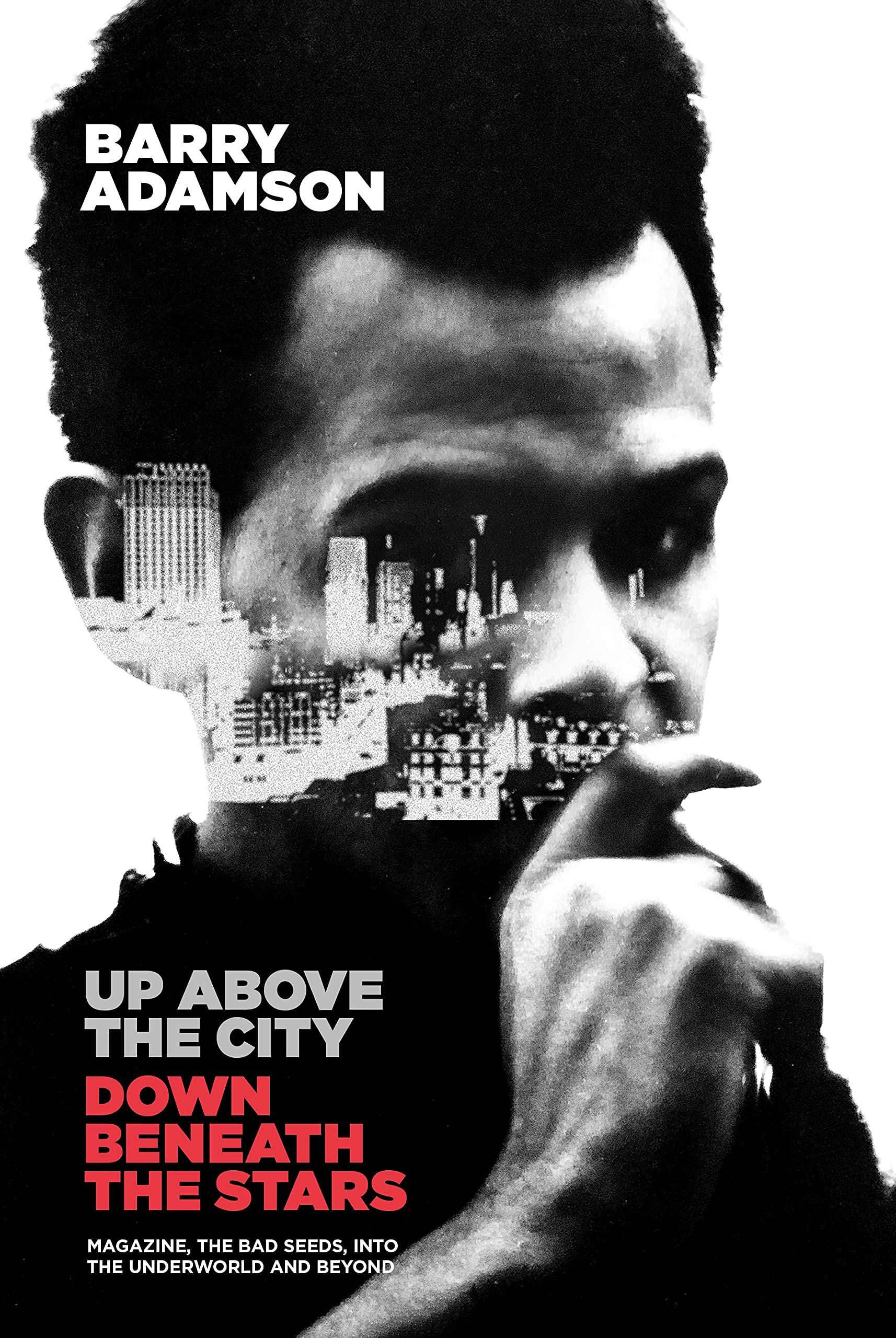Barry Adamson: Up Above the City, Down Beneath the Stars review - the post-punk colossus spills his guts in a raw style | reviews, news & interviews
Barry Adamson: Up Above the City, Down Beneath the Stars review - the post-punk colossus spills his guts in a raw style
Barry Adamson: Up Above the City, Down Beneath the Stars review - the post-punk colossus spills his guts in a raw style
The tale of a Manchester childhood, Magazine, the Bad Seeds and surviving heroin

For those not familiar with the murkier corners of British rock music history, Barry Adamson was a significant player in creating the post-punk sound of the late 1970s and early 1980s.
Up Above the City, Down Beneath the Stars is Adamson’s autobiography of growing up in a mixed-race family in Manchester’s Moss Side and Hulme, of joining Howard Devoto’s band Magazine, seemingly weeks after picking up a bass guitar for the first time and with no real musical training, helping Nick Cave to lay down his early Gothic punk blues sound and of falling victim to drug addiction, before finally cleaning himself up.
It’s a story that falls into two clear parts: his childhood in 60s and 70s Manchester – which is presented in a literary equivalent of a series of short back and white newsreels – discovering punk rock and his subsequent musical career – which heralds an altogether more dayglo writing style. The first half of the book takes some perseverance with its short tales involving school friends, his elder sister and his clearly doting parents. He is born with both his arms and legs dislocated, due a medical condition called Dyschondroplasia and maybe it is due to this or because he is very much the baby of the family, being nine years younger than his only sibling, but throughout his childhood, things just happen to him with precious little explanation, and he is left to make sense of them afterwards.

One day his parents and sisters take him on an unannounced trip to a hospital, where he eventually wakes up in a full body cast, as part of the treatment to correct his damaged legs. Later on, he comes home from school to find his dad being yelled at and slapped about by both his mum and sister, seemingly due to a sexual mis-step with a mate’s wife. Young Barry rarely sees things coming and while reflecting on these events, Old Barry rarely puts them into a cohesive narrative, but leaves them hanging. Similarly, on a family day trip to a wet Morcombe, the Adamsons end up in a cinema, watching Goldfinger. The seven-year-old Barry’s “little life is changed for ever” but, if the reader didn’t know that the theme tune was eventually covered by Magazine or that Adamson’s later solo career would be significantly influenced by John Barry’s musical style, it would be difficult to know why.
Once the teenage Barry discovers punk rock, however, the writing style changes significantly, as Adamson lays out his musical successes and personal mishaps under a bright spotlight. He buys Buzzcocks’ “Spiral Scratch” record from Paul Morley in a Stockport record shop. His mate Dave Hughes gives him a bass guitar and in no time at all he has joined one of the leading bands of the post-punk scene, just as it is forming. Soon the rock’n’roll lifestyle beckons and he’s knocking back amphetamine pills, jumping between recording studios and tours and between the sheets with numerous women, including the singer’s then girlfriend.
He is introduced to heroin and soon his behaviour metamorphizes from that of naughty young tyke to selfish monster. He becomes a father and marries his girlfriend, all between regular disappearing acts to score and shoot up, before mother and baby flee to her parents in Australia. He falls in with Nick Cave and briefly ponders the Jamaican part of his heritage, which has largely been ignored up to this point and then he is pulled up short by the deaths of his sister, mother and father, which happen in quick succession during his late 20s. It’s not quite enough to persuade him to put down the needle but begins the process and after considerably more drama, Barry finally accepts that it’s time to wise up.
At this point, the book comes to rather a juddering halt, as Adamson embarks on a new career path as respected solo artist and film score composer, but there is scant reflection, nor hints of any ongoing relationship with his daughter, Christina. Maybe this cliff-hanger is a set up for a second book, but even more than with Up Above the City Down Beneath the Stars, it’ll be unlikely to attract readers who don’t know huge swathes of the story already.
- Barry Adamson: Up Above the City, Down Beneath the Stars (Omnibus Press, £20)
- More book reviews on theartsdesk
rating
Explore topics
Share this article
Add comment
The future of Arts Journalism
You can stop theartsdesk.com closing!
We urgently need financing to survive. Our fundraising drive has thus far raised £49,000 but we need to reach £100,000 or we will be forced to close. Please contribute here: https://gofund.me/c3f6033d
And if you can forward this information to anyone who might assist, we’d be grateful.

Subscribe to theartsdesk.com
Thank you for continuing to read our work on theartsdesk.com. For unlimited access to every article in its entirety, including our archive of more than 15,000 pieces, we're asking for £5 per month or £40 per year. We feel it's a very good deal, and hope you do too.
To take a subscription now simply click here.
And if you're looking for that extra gift for a friend or family member, why not treat them to a theartsdesk.com gift subscription?
more Books
 'We are bowled over!' Thank you for your messages of love and support
Much-appreciated words of commendation from readers and the cultural community
'We are bowled over!' Thank you for your messages of love and support
Much-appreciated words of commendation from readers and the cultural community
 Justin Lewis: Into the Groove review - fun and fact-filled trip through Eighties pop
Month by month journey through a decade gives insights into ordinary people’s lives
Justin Lewis: Into the Groove review - fun and fact-filled trip through Eighties pop
Month by month journey through a decade gives insights into ordinary people’s lives
 Joanna Pocock: Greyhound review - on the road again
A writer retraces her steps to furrow a deeper path through modern America
Joanna Pocock: Greyhound review - on the road again
A writer retraces her steps to furrow a deeper path through modern America
 Mark Hussey: Mrs Dalloway - Biography of a Novel review - echoes across crises
On the centenary of the work's publication an insightful book shows its prescience
Mark Hussey: Mrs Dalloway - Biography of a Novel review - echoes across crises
On the centenary of the work's publication an insightful book shows its prescience
 Frances Wilson: Electric Spark - The Enigma of Muriel Spark review - the matter of fact
Frances Wilson employs her full artistic power to keep pace with Spark’s fantastic and fugitive life
Frances Wilson: Electric Spark - The Enigma of Muriel Spark review - the matter of fact
Frances Wilson employs her full artistic power to keep pace with Spark’s fantastic and fugitive life
 Elizabeth Alker: Everything We Do is Music review - Prokofiev goes pop
A compelling journey into a surprising musical kinship
Elizabeth Alker: Everything We Do is Music review - Prokofiev goes pop
A compelling journey into a surprising musical kinship
 Natalia Ginzburg: The City and the House review - a dying art
Dick Davis renders this analogue love-letter in polyphonic English
Natalia Ginzburg: The City and the House review - a dying art
Dick Davis renders this analogue love-letter in polyphonic English
 Tom Raworth: Cancer review - truthfulness
A 'lost' book reconfirms Raworth’s legacy as one of the great lyric poets
Tom Raworth: Cancer review - truthfulness
A 'lost' book reconfirms Raworth’s legacy as one of the great lyric poets
 Ian Leslie: John and Paul - A Love Story in Songs review - help!
Ian Leslie loses himself in amateur psychology, and fatally misreads The Beatles
Ian Leslie: John and Paul - A Love Story in Songs review - help!
Ian Leslie loses himself in amateur psychology, and fatally misreads The Beatles
 Samuel Arbesman: The Magic of Code review - the spark ages
A wide-eyed take on our digital world can’t quite dispel the dangers
Samuel Arbesman: The Magic of Code review - the spark ages
A wide-eyed take on our digital world can’t quite dispel the dangers
 Zsuzsanna Gahse: Mountainish review - seeking refuge
Notes on danger and dialogue in the shadow of the Swiss Alps
Zsuzsanna Gahse: Mountainish review - seeking refuge
Notes on danger and dialogue in the shadow of the Swiss Alps
 Patrick McGilligan: Woody Allen - A Travesty of a Mockery of a Sham review - New York stories
Fair-minded Woody Allen biography covers all bases
Patrick McGilligan: Woody Allen - A Travesty of a Mockery of a Sham review - New York stories
Fair-minded Woody Allen biography covers all bases

Comments
More a synopsis than a review